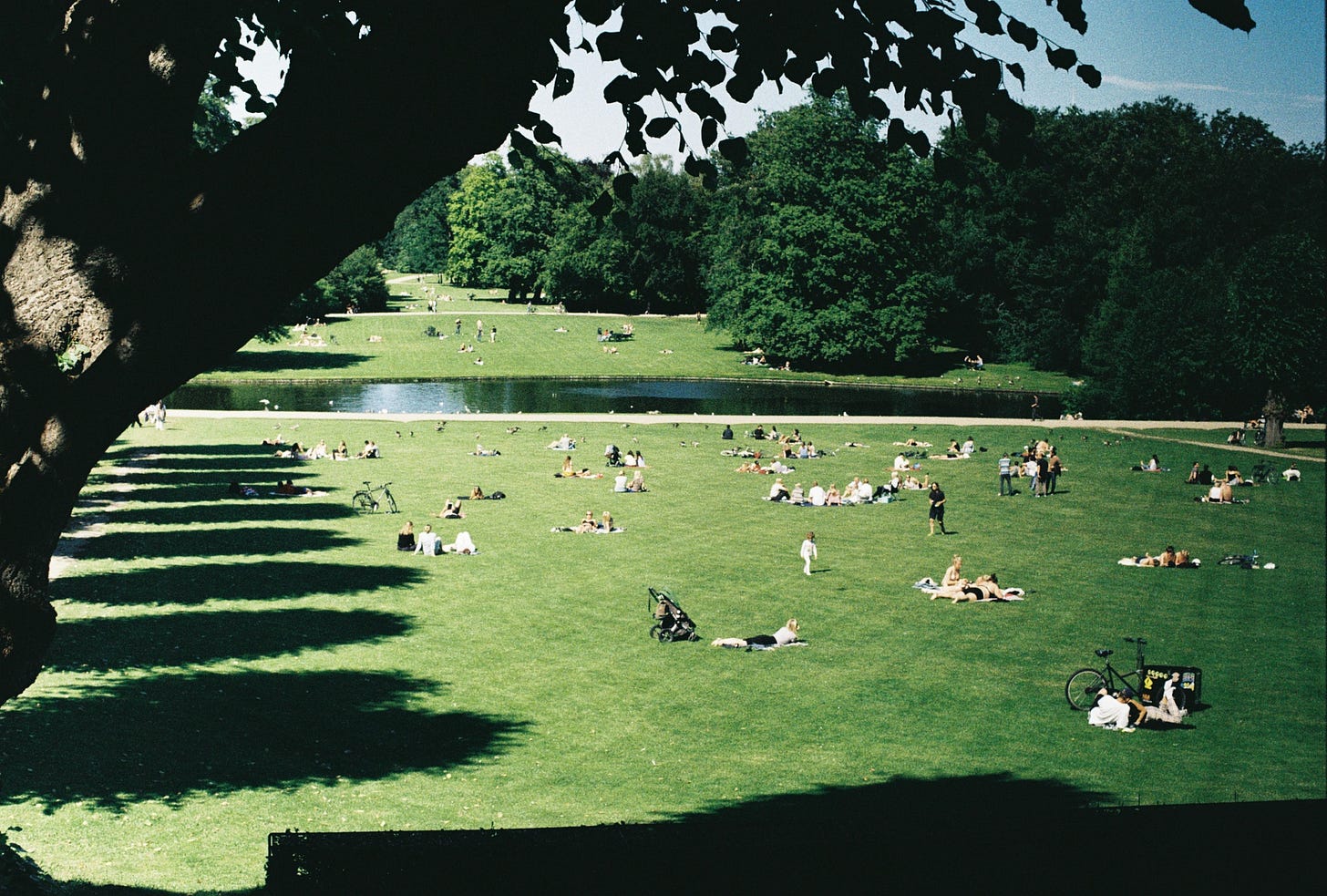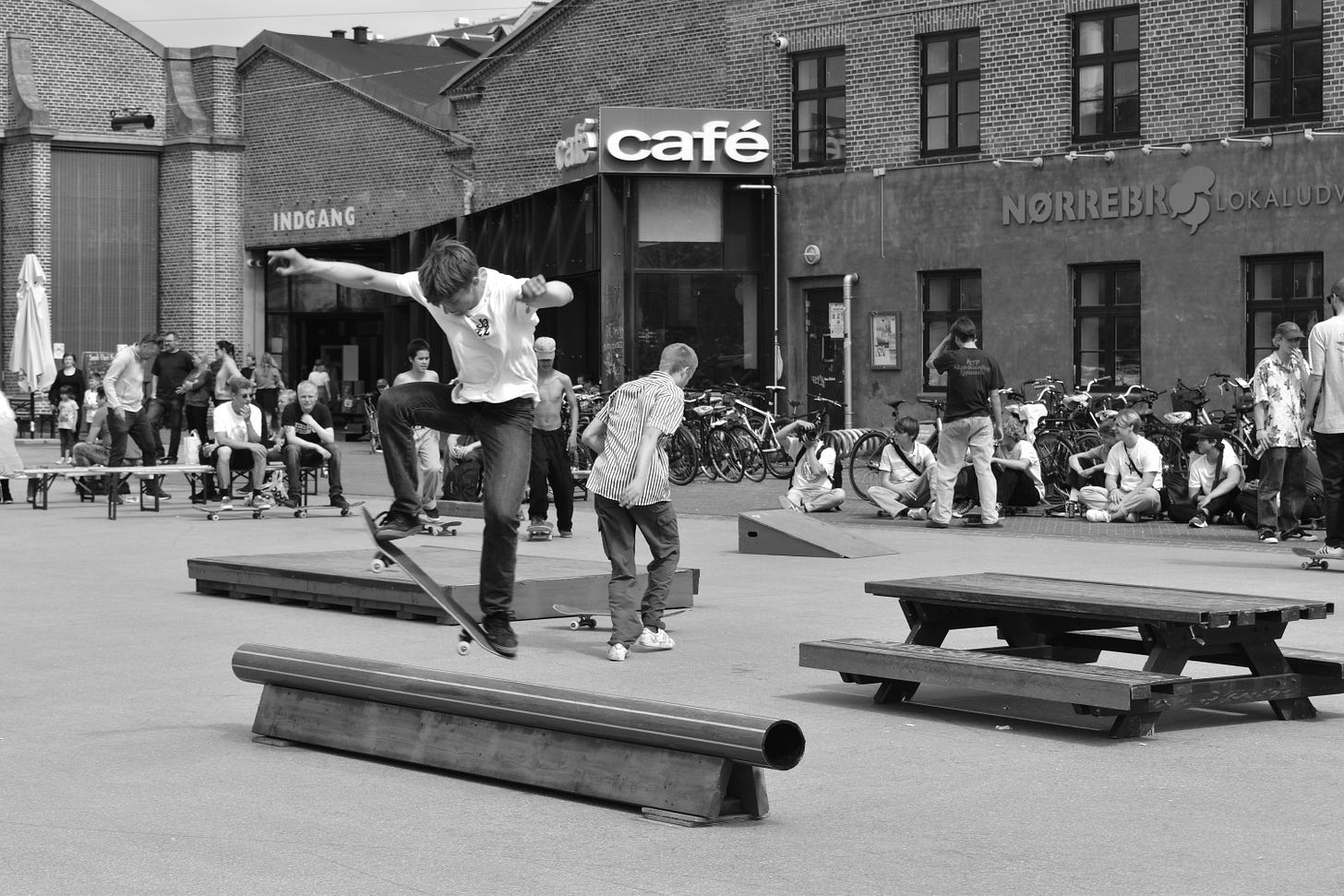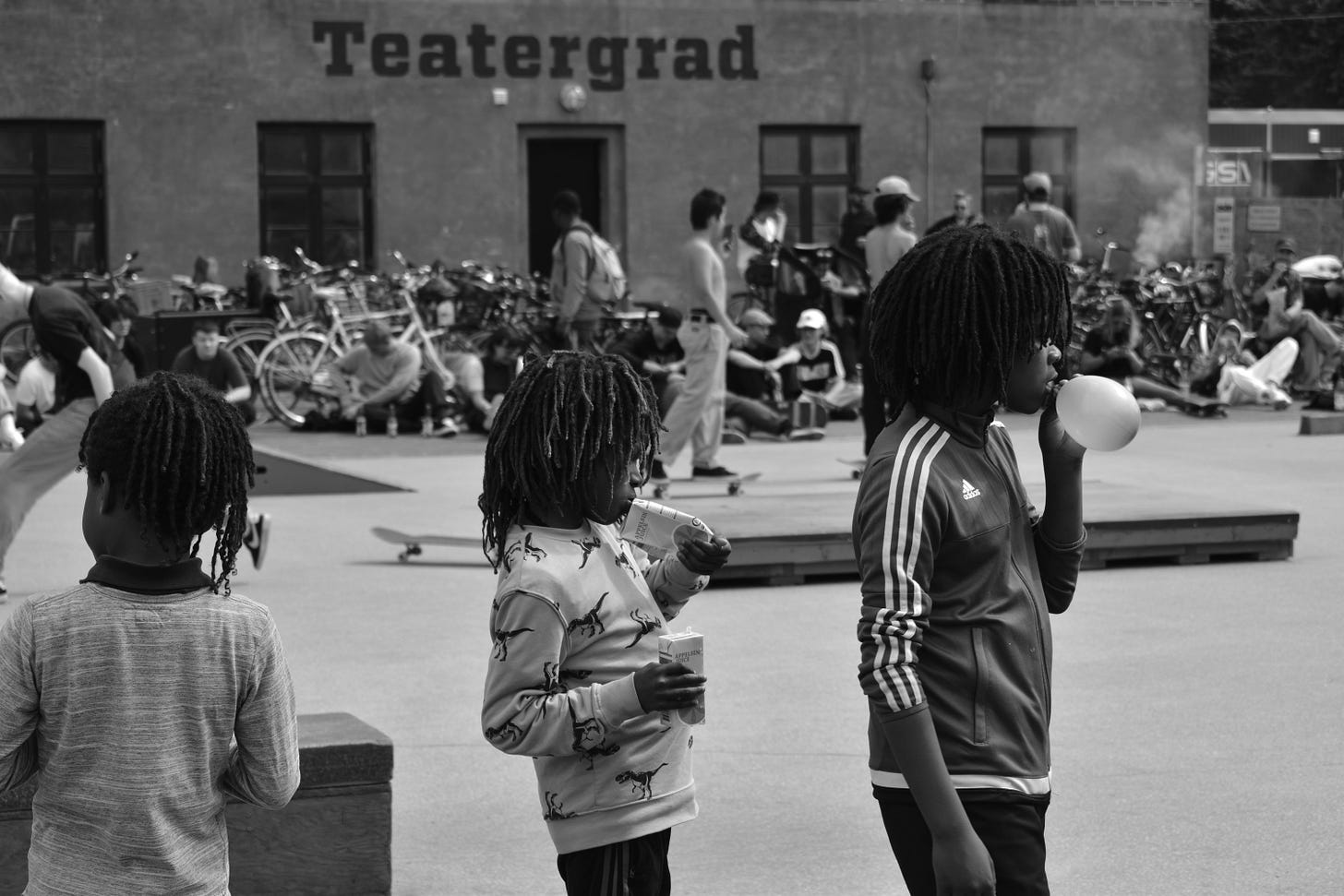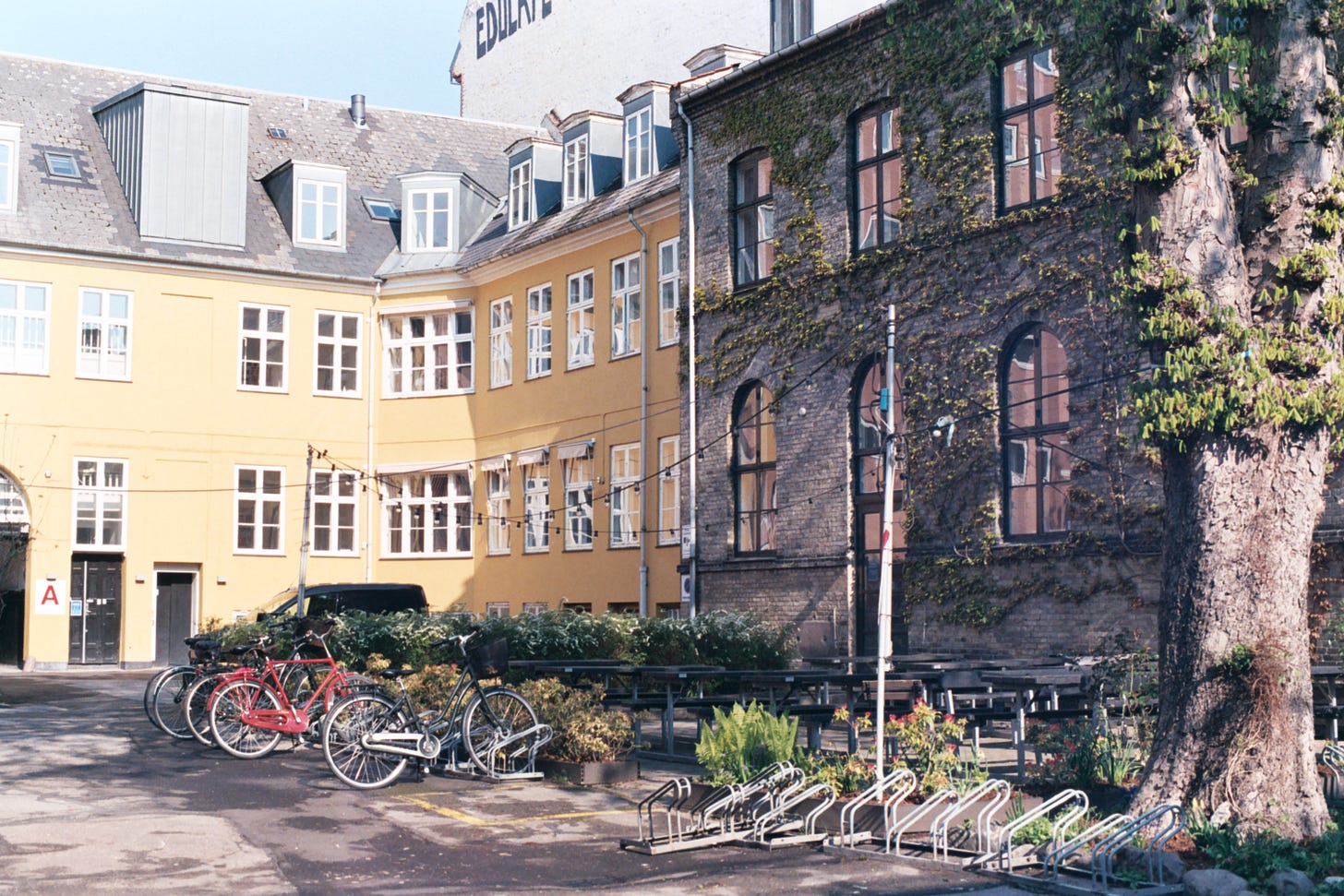Toes curled in the grass, face agape to the sun, beer probably somewhere nearby – it’s summer in Copenhagen. The day is not actually warm enough to be shirtless, and it’s definitely too soon on a Tuesday to be drinking, but that’s the magic. The rules which normally govern Danish society no longer apply. Eight months’ worth of inhibitions are collectively and decisively forgotten. The boundaries of day-to-day responsibilities disappear. Students and CEOs alike splay themselves out like drunken lizards on any available sliver of warm concrete. The very breath of the city rises in anticipation. Relaxation is priority. Sun is king.
I am leaving Copenhagen, and it is this feeling I will miss most. Nothing quite compares to the absolute bliss of an early summer’s day in Denmark. After five years, I’m always surprised by the sudden and complete unfurling of life which happens each summer. The vitality of Copenhagen during this season comes in such stark contrast to its normal operation. For much of the year, the Danish capital is reclusive. It’s not a sad or dysfunctional place by any means (in fact, usually the opposite), but there is an inhospitality to it. Copenhagen can be a tense, rigid city. And then, come May, the wonders of this great city are paraded out with tingling excitement. I love this awakening. Each year I feel it so strongly in myself. A lifting of the spirits like clockwork.
My first summer living in Copenhagen was in 2018. It’s known as the “Golden Summer” by any Dane. For months, the temperature sky-rocketed to a blistering 30 degrees Celsius (86 Fahrenheit) as the sun never seemed to sleep. People went insane. They roasted their bodies, unable to comprehend such good weather for an extended period. I was only just arriving in the city, and I couldn’t believe my good fortune. There was so much I already admired about the country – free healthcare, great public transit, a balanced work-life culture – that I was in shock that there could be so much literal and figurative warmth to the place. There was a pulse to the city that summer. Young, attractive, tanned, wealthy, educated Danes abounded. They biked around between their summer houses and hip bars and the nearest beach. With nothing to do before starting my studies that fall, I basked in it all. And for many years after, that summer defined how I thought about Denmark.
There is so much the Danish people do right. This has been well reported as a product of hygge, the Danish term for communal coziness. Hygge is both a desirable atmosphere among friends or family, as well as something of a lifestyle. It leads many Danes to sculpt their lives as a practice of maximizing time spent with loved ones in intimate places. An honorable endeavor. But while hygge is a powerful force in Danish society, I wouldn’t call it the most important. That award goes to samarbejde. Literally meaning “together work” and translated as “collaboration”, samarbejde, like hygge, is a multipurpose word. It can be used as a verb when tackling group tasks or as a noun when describing solid teamwork. “With strong samarbejde, we can do anything!”
I say samarbejde is most important to understanding the Danes because it encapsulates a sense of solidarity while staying true to the spirit of Protestant work ethic. Danes by and large no longer practice Christianity (the religion is more set-dressing for confirmations and weddings than anything else), and they have among the smallest number of weekly working hours in the OECD. But still, there’s something overwhelmingly ‘labor-centric’ in the Danish societal psyche. Danes are professional in their approach to the non-professional components of life. They rigidly schedule their hobbies into calendars. They arrange strict, bilateral meetings with friends for coffee. They plan parties to the minute, noting exactly when the appropriate time for a light-hearted music quiz will be. They organize, organize, organize.
At worst, this can be infuriating. Finding time with a good friend can require months of advanced planning. And because you’ve planned your own calendar months in advance, your friends also need to do so. Plans beget plans, and the result is a nuclear arm’s race of planning ending in mutually-assured inflexibility.
At its best, though, this spirit of professional organization blossoms into a beautiful civil society. Danes participate in their communities with serious intention. They form committees, groups, boards, and societies to ensure the betterment of the whole. The most obvious example of this is in the strength of the Danish labor unions which have, for generations, protected the rights of workers from across the professional spectrum. There are unions for metalworkers, nurses, lawyers, academics, and every group under the sun. There are collective unemployment insurance schemes, known as A-kasse, to further support workers beyond the already sizable (if not shrinking) social security net. And these are not fringe nor niche groups like they are in the US. Almost 70% of the Danish labor force dutifully pay their monthly union dues.
The collective framework of the Danish labor market, just like the scheduling hell of social life, bleeds into all aspects of Danish society. Solidarity is as important to Danes as enterprise is to Americans. The result is a people who support one another, provide ladders to the disenfranchised, and fight for the good of the group. In practice, that means good systems: Healthcare is socialized (mostly), education is both guaranteed and paid for, social security is destigmatized, and elections are representative (mostly). Denmark is often painted as a social democratic paradise, and while that is not always true (as I’ll discuss later), it can at times feel like a small societal slice of paradise. A paradise created out of collaboration and structured work. Work that, I’m confident in saying, was almost certainly unionized.
Looking from the right angle, Copenhagen is the world’s best city. It makes sense that it often ranks at the top of “most livable cities” lists. Things just work here. Both the public transit and cycle infrastructure make movement effortless. If you ever find yourself screaming at grid-locked traffic or a delayed train, Copenhagen can be a breath of fresh air.
It also helps that the city is small. Within fifteen minutes, you can be almost anywhere in the city no matter where you live. For most of my life here I’ve had little to no commute save a seven-minute bike ride along the man-made canals known as “the lakes”. The ease of transportation makes it painless to combine plans with people in a different neighborhood or just drop off your backpack after work. That freedom then grows into a people-focused cityscape. There’s no long drive home keeping you from going to a concert or movie. There’s little to no pollution or traffic to slowly (or quickly) kill you. The city can be disconcertingly quiet at times. And perhaps under-discussed but wildly impactful, Copenhagen is safe. I have never once felt unsafe here. Female friends have told me they’ve never been cat-called here, or if they have, it’s felt so out of place to be a bit ridiculous. There’s no neighborhood I wouldn’t go to any time of day.
And there are great neighborhoods in the city. Nørrebro is probably the most famous, having been named “The coolest neighborhood in the world” in 2021. Nørrebro is cool, there’s no denying that. You cruise through Nørrebroparken, the big green space which slices through the southwestern edge of the neighborhood, with a drink and a falafel in your hands to watch the skateboarders flip around in the Red Square, and you think, “This is cool.” In my eyes, it can be a little too cool, especially once you start thinking about the wave of gentrification which has chased out, sometimes forcefully, the diverse communities which gave the neighborhood a variety which the rest of the city lacks.
Vesterbro, which I would consider my home neighborhood, is not much better when it comes to diversity, but it does have less of the sheen of Nørrebro and its hyper-hip aesthetic. For most of its history, Vesterbro was a working-class neighborhood with a certain literary bent. Many famous poets and writers, most notably the author Tove Ditlevsen, hail from Vesterbro. The neighborhood was (and still in some ways is) the old redlight district of Copenhagen. Vesterbro became famous for its brune værtshuse, “brown bars”, where hearty locals would play Danish billiards, drink dozens of Tuborgs, and smoke until the smell caked deep into the wooden floors and benches. By the 1980’s, the neighborhood became synonymous with open drug use. Users found refuge in the community centers and parks thanks to a police approach known as “nonenforcement”. Today, you’d have a hard time recognizing those sharper elements of Vesterbro’s history. The neighborhood now caters to yuppie couples and their babies as they compete for stroller space on the bustling street of Istedgade. Still, there remains a certain edge, a recognition of what the neighborhood once was, how it's improved, and what has been lost along the way.
I’ve lived in nearly every neighborhood of Copenhagen. From the cute micro-town of Valby to the proud and “provincial” Amager, the areas of the city each have their own distinct atmosphere. Sadly, as is happening in most of the rest of the world’s cities, the variation between neighborhoods is slowly disappearing. Clean, cool, unblemished, tourist-friendly Pan-Europea is spreading its innocuous claws and twelve-dollar beers into all areas of the city. Truthfully, I never knew the old Copenhagen. I’ve been part of the tidal wave of internationalization marked by hip climbing gyms and taco joints with neon-pink signs. For now, though, I don’t think the transformation is too tragic. Copenhagen in 2023 is vibrant with art and community. Its streets are well managed and safe. People come and go, stop to swim in the canals, and lounge in the many parks. It’s a great city, and I’ll miss it dearly.
It’s important for me to say Denmark and its capital are not without flaws. Marcellus’ famous words in Hamlet, “Something is rotten in the state of Denmark,” still ring true today. For all the praise I’ve heaped on the country for its values of solidarity, community, and progressiveness, I can’t say that these values apply to everyone. Danes support the collective, that is undeniable, but the reality stands that not everyone is considered part of that collective. The “us” is remarkably strong in Denmark but so too is the “them”.
Starting from my own easier experience as a university-educated white man, Denmark can be frustratingly insular. Breaking into society – into friend groups or organizations – can be a mammoth, if not impossible, task. Danes form their social bonds early. Most still regularly meet with grade school friends or friend groups from gymnasium, what we would consider high school. Those bonds can be woven so tightly that outsiders are not allowed in or even thought to be included. As with the professionalization of social life, most arrangements with Danish people are within the confines in which you already know them. Colleagues meet at Friday bars, but not on the weekend. University mates don’t mix with kindergarten pals. Danes are nice. Danes are inclusive. But Danes will not invite you to hang out with their friends.
Language doesn’t help here. Though grammatically simple, Danish is an amorphous, punishing language that does not welcome outsiders. Learners struggle for years, maybe their whole lives, to pronounce even the most basic guttural sounds and glottal stops which decorate the language. Monolinguists (after passing many tests, I’m still greatly in doubt whether I’ve graduated to dual) tend to overlook how speaking another language can be taxing on the muscles of the mouth and throat. In this realm, Danish is like one of those massive drills they use to carve tunnels through mountains: Undiscerning and abrasive. It doesn’t help that Danes, especially those on the island of Zealand, home to Copenhagen, tend to smash sounds together and cut off the endings of words. The result is somehow both staccato and loose, a language both rigid and impossibly goopy.
Most difficult are the vowels. Danish has three extra vowel letters: Å, Æ, Ø. Where, thankfully, only the Ø is a completely foreign sound to English speakers. The sounds themselves can be a challenge (especially when combo’ed with the infamous soft d), but the real trick is the precision. Unlike most languages, the ability to correctly speak and understand Danish rests heavily on the precision of vowel sounds. In English, you can generally get away with mispronouncing the vowels in a word so long as you have the consonants in the right ballpark. Danish is never so kind. For years, I couldn’t get across words that contained an Ø. I would draw blank expressions from friends when trying to say pølse (sausage) or sø (sea). Then someone told me the easy way to pronounce it was to mimic the noise a seal makes when begging for food. I’ve been employing that advice ever since, and it seems to have helped tremendously.
The truth of Danish is that it’s largely a gate-keeping tool. Most Danes speak English, anyone under thirty probably quite well. You can live for years successfully in Denmark as a foreigner by speaking English alone. To my great shame, I still almost exclusively speak English outside of interactions with strangers on the street. A major reason for this is how Danes will instantly switch to English once they realize you are not a native speaker. They hear some twang of Americana and switch to match. To be clear, I don’t blame them in the slightest. They want to accommodate you, as English for them is a breeze compared to listening to your bad Danish. If you want to truly learn Danish, though, it can be a frustrating experience. The three close foreign friends of mine who speak Danish at a professional level have done so only through sheer force of will. They refused to speak English in their private lives, offices, and with code-switching baristas. It’s a great idea in theory, but frankly, I’ve never had the discipline.
Without a mastery of the language, then, foreigners struggle to access the inner circles of Danish society. Day-to-day life zips by in English, but if you want to participate meaningfully and with longevity in Danish clubs, organizations, or friend groups, tough luck. Come back after dating a Dane for two years and watching every episode of Matador.
In the grand scheme, it’s a minor gripe. The exclusivity of a life in Danish is just as particular as anywhere else in the world. However, I can’t help but see this linguistic insularity as a clear example of an “in-group” mentality. Danes find it endearing when you attempt to speak their language. They’ll welcome you to their beautiful country and show you around in your own language. But what they won’t do is think of you as part of Denmark. You may look like me, and think like me, but you don’t talk like me and are not part of the whole.
And that’s where the darkest part of Danish society – and especially the Danish state – lies. What if you don’t think like them? And, more importantly, what if you don’t look like them?
Beyond the run-of-the-mill prejudice common in most of the West, Denmark has some of the worst policies toward foreigners, migrants, refugees, and asylum seekers in Europe. From creating “ghetto lists” of targeted neighborhoods to break up migrant communities1 to a proposal to outsource asylum cases to centers in Rwanda23, the Danish authorities have continuously instituted new policies which hinder, degrade, and marginalize “outsiders'', especially those who are brown and black. Even those born and raised in Denmark have been refused citizenship4. And for those who haven’t grown up in Denmark but would like to become citizens, the state is only introducing more complicated requirements in an attempt to discourage potential applicants5. These egregious abuses and policies demonstrate how Denmark has for many years intentionally and systematically made the lives of migrants and asylum seekers more difficult in the hopes of discouraging them from coming here.
The argument is often about integration. Can they fit within the structures of Danish society which make it so beneficial to the collective? In some ways that question make sense. Denmark does have highly functional, state-operated social security systems that require buy-in from the public. Without that collective agreement, the pieces of the welfare state fall apart. But, in my opinion, Danes use that line of thought not to consider how best to learn from and incorporate new people into their culture but to masquerade their racism.
That question was not asked of white Ukrainian refugees who, fleeing war, showed up at Denmark’s door in the Spring of 20226. Samarbejde doesn’t mean sending Syrian refugees back to areas where they “face grave human rights abuses and persecution”7. A progressive state doesn’t forcibly evict people of migrant backgrounds to achieve a “more balanced composition between non-westerners [and] ‘native’ Danes”8. Time and again in my five years here, Denmark has proven to me that it wants to protect “us” at the expense of “them”. The thought of integration by addition, by diversity, is not part of the Danish lexicon. That binary is immutable. And as someone who looks like “us” but feels like “them”, I find it detestable.
So where does that leave me? Five years, five summers, three visas, ten living arrangements, three relationships, two jobs, and countless friends later, what more is there to say about Copenhagen? I’ve had the best years of my life here as a student. I also lived through two terrible Corona years. I have been at my happiest among great people who have welcomed me into their lives. I have also felt systematically discouraged from making Denmark my home. Denmark to me is a country of opposites. Here, you are free to be whoever, love whoever, or say whatever you want. But at the same time, all manner of nonconformity is socially stamped out by the collective.
I love this country, I really do. There’s so much the Danes have fostered on this unremarkable set of islands and peninsulas that the rest of the world should aspire to. And Copenhagen will always be a home to me. Yet I can’t help but taste a sourness in my mouth. I feel more like a foreigner now than the day I arrived. I feel outside of whatever it is the Danes have created, and my reaction is to push away rather than try my luck at making the team. Ah, it’s such a shame. The summer is only just here! But while Denmark might be a warm place in the sun, it can be a frigid place in the shade.
The proposal has been tabled since the most recent Danish general election in late 2022.










Wow. Fabulous piece of writing. What a great job of writing about the delicate dance between the “winter” and “summer” of a country you both love and choose to leave.
I enjoyed this! I have now added another city to the travel list 👍🏼